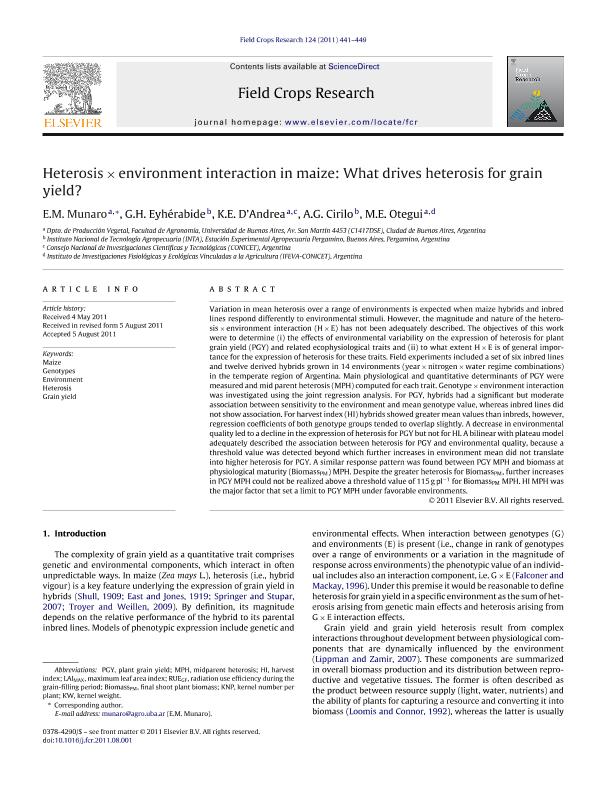Artículo
Heterosis × environment interaction in maize: What drives heterosis for grain yield?
Fecha de publicación:
12/2011
Editorial:
Elsevier
Revista:
Field Crops Research
ISSN:
0378-4290
Idioma:
Inglés
Tipo de recurso:
Artículo publicado
Clasificación temática:
Resumen
Variation in mean heterosis in maize over a range of environments can be expected when hybrids and inbred lines respond differently to environmental stimuli however, the magnitude and nature of heterosis x environment (H x E) interaction has not been adequately described. The objectives of this work were (i) to determine the effects of environmental variability on the expression of grain yield and ecophysiological traits in a set of six inbred lines and their derived hybrids grown in 14 environments (year x nitrogen x water regime combinations) and (ii) to what extent H x E interactions are of general importance for the expression of heterosis for these traits. Field experiments were conducted at Pergamino, Argentina during 2002-2003, 2003-2004, 2004-2005, 2006-2007 and 2008-2009 growing seasons. The variability among experiments was manipulated by applying supplemental irrigation or dry land farming and two nitrogen levels. Main physiological and quantitative determinants of grain yield were measured and mid parent heterosis (MPH) computed for each trait. Genotype x environment interaction was investigated using the joint regression. For plant grain yield (PGY), hybrids had a significant but moderate association between environmental sensitivity and mean genotype value, whereas inbred lines did not show association. For HI hybrids showed greater mean values than inbred, however, regression coefficients of both genotype groups tended to overlap slightly. A decrease in environmental quality led to a decline in the expression of heterosis for PGY but not for HI. A bilinear model adequately described the association between heterosis for PGY and environmental quality and we identified the existence of a threshold value beyond which further increases in environmental quality did not translate into higher heterosis for PGY. A similar response pattern was found between PGY MPH and BiomassPM MPH. Despite the greater heterosis for BiomassPM, further increases in PGY MPH could not be realized above a threshold value of 115 g pl for BiomassPM MPH representative of high quality environments. HI MPH was the major factor that set a limit to PGY.
Palabras clave:
Maize
,
Genotypes
,
Environment
,
Heterosis
Archivos asociados
Licencia
Identificadores
Colecciones
Articulos(IFEVA)
Articulos de INST.D/INV.FISIOLOGICAS Y ECO.VINCULADAS A L/AGRIC
Articulos de INST.D/INV.FISIOLOGICAS Y ECO.VINCULADAS A L/AGRIC
Articulos(OCA PQUE. CENTENARIO)
Articulos de OFICINA DE COORDINACION ADMINISTRATIVA PQUE. CENTENARIO
Articulos de OFICINA DE COORDINACION ADMINISTRATIVA PQUE. CENTENARIO
Citación
Munaro, E. M.; Eyherabide, G. H.; D'andrea, Karina Elizabeth; Cirilo, A. G.; Otegui, Maria Elena; Heterosis × environment interaction in maize: What drives heterosis for grain
yield?; Elsevier; Field Crops Research; 124; 3; 12-2011; 441-449
Compartir
Altmétricas




